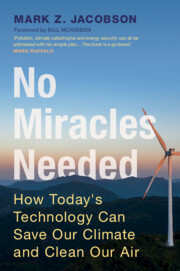Book contents
- No Miracles Needed
- Reviews
- No Miracles Needed
- Copyright page
- Dedication
- Contents
- Figures
- Foreword
- Preface
- 1 What Problems Are We Trying to Solve?
- 2 WWS Solutions for Electricity Generation
- 3 WWS Solutions for Electricity Storage
- 4 WWS Solutions for Transportation
- 5 WWS Solutions for Buildings
- 6 WWS Solutions for Industry
- 7 Solutions for Nonenergy Emissions
- 8 What Doesn’t Work
- 9 Electricity Grids
- 10 Photovoltaics and Solar Radiation
- 11 Onshore and Offshore Wind Energy
- 12 Steps in Developing 100 Percent WWS Roadmaps
- 13 Keeping the Grid Stable with 100 Percent WWS
- 14 Timeline and Policies Needed to Transition
- 15 My Journey
- References
- Index
12 - Steps in Developing 100 Percent WWS Roadmaps
Published online by Cambridge University Press: 02 February 2023
- No Miracles Needed
- Reviews
- No Miracles Needed
- Copyright page
- Dedication
- Contents
- Figures
- Foreword
- Preface
- 1 What Problems Are We Trying to Solve?
- 2 WWS Solutions for Electricity Generation
- 3 WWS Solutions for Electricity Storage
- 4 WWS Solutions for Transportation
- 5 WWS Solutions for Buildings
- 6 WWS Solutions for Industry
- 7 Solutions for Nonenergy Emissions
- 8 What Doesn’t Work
- 9 Electricity Grids
- 10 Photovoltaics and Solar Radiation
- 11 Onshore and Offshore Wind Energy
- 12 Steps in Developing 100 Percent WWS Roadmaps
- 13 Keeping the Grid Stable with 100 Percent WWS
- 14 Timeline and Policies Needed to Transition
- 15 My Journey
- References
- Index
Summary
So far, this book has examined the main technologies needed for a 100 percent clean, renewable energy and storage system. Virtually all of these technologies exist today, and none is a miracle technology. This chapter focuses on combining the technologies together in countries, states, cities, and towns to provide end-point roadmaps for a transition. Such roadmaps provide targets for meeting all-purpose power demand with 100 percent WWS in the annual average by some year, often 2050, but ideally sooner, such as 2035. Chapter 13 discusses methods of matching power demand continuously (rather than in the annual average) with WWS supply, storage, and demand response Roadmaps and grid stability analyses are helpful for giving policymakers, utilities, and the public confidence that a transition will not cause grid failures, particularly during extreme weather events.
Keywords
- Type
- Chapter
- Information
- No Miracles NeededHow Today's Technology Can Save Our Climate and Clean Our Air, pp. 261 - 278Publisher: Cambridge University PressPrint publication year: 2023

